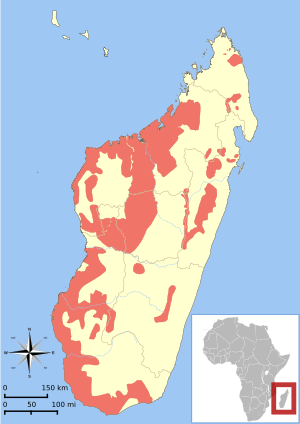Sifaka facts for kids
Quick facts for kids Sifakas |
|
|---|---|
 |
|
| Coquerel's sifaka (P. coquereli) | |
| Conservation status | |
| Scientific classification | |
| Type species | |
| Propithecus diadema Bennett, 1832
|
|
| Diversity | |
| 9 species | |
 |
|
| Combined distribution of Propithecus | |
| Synonyms | |
|
A sifaka is a type of lemur found only on the island of Madagascar. Sifakas belong to the group of animals called Primates. They are part of the Indriidae family. Their name sounds like their special alarm call, "shi-fak!"
All types of sifakas are currently threatened. Some are vulnerable, while others are critically endangered. This means they need our help to survive.
Contents
What Do Sifakas Look Like?
Sifakas are medium-sized lemurs. Their bodies are about 40 to 55 centimeters (16 to 22 inches) long. They weigh between 3 and 6 kilograms (7 to 13 pounds). Their tail is as long as their body. This helps tell them apart from another lemur called the Indri.
Sifakas have long, silky fur. The color of their fur changes depending on the species. It can be yellowish-white or even dark brownish-black. Their face is round and black, with no fur. Like all lemurs, sifakas have special tools for grooming. They have a "toilet-claw" on their second toe. They also have a "toothcomb" made from their front teeth.
How Do Sifakas Move?
Sifakas are amazing acrobats in the trees! They move by clinging to tree trunks and leaping. They stay upright as they jump from one tree to another. They can also move along branches with ease.
These lemurs are very skilled climbers. They are also powerful jumpers. They can leap up to 10 meters (33 feet) from one tree to the next! When they are on the ground, sifakas move differently. They hop sideways on their back legs. They hold their front legs up to help them balance. Sifakas are active during the day. They spend most of their time in trees.
What Do Sifakas Eat and How Do They Live?
Sifakas are herbivores. This means they only eat plants. Their diet includes leaves, flowers, and fruits. When they are not looking for food, they enjoy sunbathing. They stretch out on tree branches to soak up the sun.
Sifakas live in groups. Their groups are usually larger than other lemurs in their family. A group can have up to 13 animals. They have a specific area they call home. They mark their territory using special scent glands. Sometimes, the edges of different sifaka territories might overlap.
Even though they protect their territory from other sifakas, they can live peacefully with other lemur species. For example, they might share space with red-bellied lemurs or common brown lemurs.
Who Are Sifaka Predators?
Sifakas have natural enemies. One main predator is the fossa. The fossa is a cat-like mammal that also lives in Madagascar. Birds of prey, like hawks, also hunt sifakas from the sky.
Sifakas usually escape these attacks with their quick movements. They are very agile in the trees, staying high above the ground. However, sifakas can also defend themselves. They have been seen biting and scratching attackers. Some have even fought off a Madagascar ground boa!
Sifaka Life Cycle and Reproduction
Female sifakas carry their babies for about four to five months. They usually give birth to one baby in July. When the baby is very small, it holds tightly to its mother's belly. As it grows, the mother carries it on her back.
Young sifakas drink their mother's milk for about six months. They become fully grown when they are two or three years old. Sifakas can live for up to 20 years in the wild.
Types of Sifakas
There are several different types of sifakas. Scientists group them into two main categories. These groups are based on where they live and how they are related.
- Family Indriidae
- Genus Indri
- Genus Avahi
- Genus Propithecus
- P. diadema group
- Diademed sifaka, P. diadema
- Milne-Edwards's sifaka, P. edwardsi
- Silky sifaka, P. candidus
- Perrier's sifaka, P. perrieri
- P. verreauxi group
- Coquerel's sifaka, P. coquereli
- Verreaux's sifaka, P. verreauxi
- Von der Decken's sifaka, P. deckenii
- Crowned sifaka, P. coronatus
- Golden-crowned sifaka, P. tattersalli
- P. diadema group
Images for kids
-
Sifaka skeleton
See also
 In Spanish: Sifacas para niños
In Spanish: Sifacas para niños








